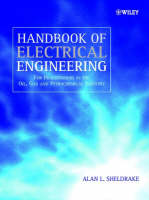Handbook of Electrical Engineering
 -15%
portes grátis
-15%
portes grátis
Handbook of Electrical Engineering
For Practitioners in the Oil, Gas and Petrochemical Industry
Sheldrake, Alan L.
John Wiley & Sons Inc
04/2003
650
Dura
Inglês
9780471496311
15 a 20 dias
1320
Preface xxi
Acknowledgements xxiii
About the Author xxv
1 Estimation of Plant Electrical Load 1
1.1 Preliminary Single-Line Diagrams 1
1.2 Load Schedules 2
1.2.1 Worked example 5
1.3 Determination of Power Supply Capacity 8
1.4 Standby Capacity of Plain Cable Feeders and Transformer Feeders 12
1.5 Rating of Generators in Relation to their Prime Movers 13
1.5.1 Operation at low ambient temperatures 13
1.5.2 Upgrading of prime movers 13
1.6 Rating of Motors in Relation to their Driven Machines 13
1.7 Development of Single-Line Diagrams 14
1.7.1 The key single line diagram 15
1.7.2 Individual switchboards and motor control centres 15
1.8 Coordination with other Disciplines 16
1.8.1 Process engineers 16
1.8.2 Mechanical engineers 17
1.8.3 Instrument engineers 17
1.8.4 Communication and safety engineers 18
1.8.5 Facilities and operations engineers 18
Reference 18
2 Gas Turbine Driven Generators 19
2.1 Classification of Gas Turbine Engines 19
2.1.1 Aero-derivative gas turbines 19
2.1.2 Light industrial gas turbines 20
2.1.3 Heavy industrial gas turbines 20
2.1.4 Single and two-shaft gas turbines 20
2.1.5 Fuel for gas turbines 23
2.2 Energy Obtained from a Gas Turbine 23
2.2.1 Effect of an inefficient compressor and turbine 29
2.2.2 Maximum work done on the generator 30
2.2.3 Variation of specific heat 31
2.2.4 Effect of ducting pressure drop and combustion chamber pressure drop 32
2.2.5 Heat rate and fuel consumption 35
2.3 Power Output from a Gas Turbine 36
2.3.1 Mechanical and electrical power losses 37
2.3.2 Factors to be considered at the design stage of a power plant 37
2.4 Starting Methods for Gas Turbines 39
2.5 Speed Governing of Gas Turbines 39
2.5.1 Open-loop speed-torque characteristic 39
2.5.2 Closed-loop speed-power characteristic 41
2.5.3 Governing systems for gas turbines 43
2.5.4 Load sharing between droop-governed gas turbines 44
2.5.5 Load sharing controllers 50
2.6 Mathematical Modelling of Gas Turbine Speed Governing Systems 52
2.6.1 Modern practice 52
2.6.2 Typical parameter values for speed governing systems 59
References 59
Further Reading 59
3 Synchronous Generators and Motors 61
3.1 Common Aspects Between Generators and Motors 61
3.2 Simplified Theory of Operation of a Generator 61
3.2.1 Steady state armature reaction 62
3.2.2 Transient state armature reaction 63
3.2.3 Sub-transient state armature reaction 63
3.3 Phasor Diagram of Voltages and Currents 64
3.4 The Derived Reactances 65
3.4.1 Sensitivity of X md , X a , X f and X kd to Changes in Physical dimensions 67
3.5 Active and Reactive Power Delivered from a Generator 68
3.5.1 A general case 68
3.5.2 The particular case of a salient pole generator 70
3.5.3 A simpler case of a salient pole generator 71
3.6 The Power Versus Angle Chart of a Salient Pole Generator 72
3.7 Choice of Voltages for Generators 73
3.8 Typical Parameters of Generators 73
3.9 Construction Features of High Voltage Generators and Induction Motors 78
3.9.1 Enclosure 78
3.9.2 Reactances 79
3.9.3 Stator windings 79
3.9.4 Terminal boxes 80
3.9.5 Cooling methods 80
3.9.6 Bearings 80
References 81
4 Automatic Voltage Regulation 83
4.1 Modern Practice 83
4.1.1 Measurement circuits 83
4.1.2 Error sensing circuit 84
4.1.3 Power amplifier 84
4.1.4 Main exciter 88
4.2 IEEE Standard AVR Models 89
4.2.1 Worked example 92
4.2.2 Worked example 92
4.2.3 Determining of saturation constants 93
4.2.4 Typical parameter values for AVR systems 97
Reference 97
5 Induction Motors 99
5.1 Principle of Operation of the Three-Phase Motor 99
5.2 Essential Characteristics 100
5.2.1 Motor torque versus speed characteristic 100
5.2.2 Motor starting current versus speed characteristic 107
5.2.3 Load torque versus speed characteristic 108
5.2.4 Sensitivity of characteristics to changes in resistances and reactances 109
5.2.5 Worked example 109
5.2.6 Typical impedance data for two-pole and four-pole induction motors 114
5.2.7 Representing the deep-bar effect by two parallel branches 114
5.3 Construction of Induction Motors 119
5.4 Derating Factors 121
5.5 Matching the Motor Rating to the Driven Machine Rating 121
5.6 Effect of the Supply Voltage on Ratings 122
5.7 Effect of the System Fault Level 123
5.8 Cable Volt-drop Considerations 123
5.9 Critical Times for Motors 125
5.10 Methods of Starting Induction Motors 125
5.10.1 Star-delta method 126
5.10.2 Korndorfer auto-transformer method 126
5.10.3 Soft-start power electronics method 127
5.10.4 Series reactor method 128
5.10.5 Part winding method 129
References 129
6 Transformers 131
6.1 Operating Principles 131
6.2 Efficiency of a Transformer 134
6.3 Regulation of a Transformer 135
6.4 Three-Phase Transformer Winding Arrangements 136
6.5 Construction of Transformers 137
6.5.1 Conservator and sealed type tanks 139
6.6 Transformer Inrush Current 140
References 142
7 Switchgear and Motor Control Centres 143
7.1 Terminology in Common Use 143
7.2 Construction 144
7.2.1 Main busbars 144
7.2.2 Earthing busbars 146
7.2.3 Incoming and busbar section switching device 146
7.2.4 Forms of separation 147
7.2.5 Ambient temperature derating factor 149
7.2.6 Rated normal current 149
7.2.7 Fault making peak current 149
7.2.8 Fundamental AC part 150
7.2.9 DC part 150
7.2.10 Double frequency AC part 150
7.2.11 Fault breaking current 152
7.2.12 Fault withstand duty 153
7.3 Switching Devices 154
7.3.1 Outgoing switching device for switchgear 154
7.3.2 Outgoing switching device for motor control centres 155
7.4 Fuses for Motor Control Centre Outgoing Circuits 156
7.5 Safety Interlocking Devices 157
7.6 Control and Indication Devices 158
7.6.1 Restarting and reaccelerating of motors 158
7.6.2 Micro-computer based systems 159
7.7 Moulded Case Circuit Breakers 162
7.7.1 Comparison with fuses 162
7.7.2 Operating characteristics 163
7.7.3 Cut-off current versus prospective current 164
7.7.4 i-squared-t characteristic 164
7.7.5 Complete and partial coordination of cascaded circuit breakers 165
7.7.6 Worked example for coordination of cascaded circuit breakers 167
7.7.7 Cost and economics 172
References 172
8 Fuses 173
8.1 General Comments 173
8.2 Operation of a Fuse 174
8.3 Influence of the Circuit X-to-R Ratio 174
8.4 The I 2 t Characteristic 176
8.4.1 Worked example 179
References 181
9 Cables, Wires and Cable Installation Practices 183
9.1 Electrically Conducting Materials used in the Construction of Cables 183
9.1.1 Copper and aluminium 184
9.1.2 Tin 184
9.1.3 Phosphor bronze 185
9.1.4 Galvanised steel 185
9.1.5 Lead 186
9.2 Electrically Non-Conducting Materials used in the Construction of Cables 187
9.2.1 Definition of basic terminology 187
9.3 Composition of Power and Control Cables 191
9.3.1 Compositional notation 192
9.3.2 Conductor 192
9.3.3 Conductor semiconducting screen 196
9.3.4 Insulation 196
9.3.5 Insulation semiconductor screen 197
9.3.6 Inner sheath 197
9.3.7 Lead sheathing 197
9.3.8 Armouring 198
9.3.9 Outer sheath 198
9.4 Current Ratings of Power Cables 198
9.4.1 Continuous load current 198
9.4.2 Continuous rated current of a cable 199
9.4.3 Volt-drop within a cable 209
9.4.4 Protection against overloading current 242
9.5 Cables with Enhanced Performance 244
9.5.1 Fire retardance 244
9.5.2 Fire resistance 245
9.5.3 Emission of toxic gases and smoke 245
9.5.4 Application of fire retardant and fire resistant cables 246
Reference 247
10 Hazardous Area Classification and the Selection of Equipment 249
10.1 Historical Developments 249
10.2 Present Situation 249
10.3 Elements of Hazardous Area Classification 251
10.3.1 Mixtures of gases, vapours and air 251
10.4 Hazardous Area Zones 253
10.4.1 Non-hazardous area 253
10.4.2 Zone 2 hazardous area 253
10.4.3 Zone 1 hazardous area 253
10.4.4 Zone 0 hazardous area 254
10.4.5 Adjacent hazardous zones 254
10.5 Types of Protection for Hazardous Areas 254
10.5.1 Type of protection 'd' 255
10.5.2 Type of protection 'e' 256
10.5.3 Type of protection 'i' 256
10.5.4 Type of protection 'm' 257
10.5.5 Type of protection 'n' and 'n' 257
10.5.6 Type of protection 'o' 258
10.5.7 Type of protection 'p' 258
10.5.8 Type of protection 'q' 259
10.5.9 Type of protection 's' 259
10.5.10 Type of protection 'de' 259
10.6 Types of Protection for Ingress of Water and Solid Particles 260
10.6.1 European practice 260
10.6.2 American practice 261
10.7 Certification of Hazardous Area Equipment 265
10.8 Marking of Equipment Nameplates 266
References 266
Further Reading 266
11 Fault Calculations and Stability Studies 269
11.1 Introduction 269
11.2 Constant Voltage Source - High Voltage 269
11.3 Constant Voltage Source - Low Voltage 271
11.4 Non-Constant Voltage Sources - All Voltage Levels 273
11.5 Calculation of Fault Current due to Faults at the Terminals of a Generator 274
11.5.1 Pre-fault or initial conditions 274
11.5.2 Calculation of fault current - RMS symmetrical values 276
11.6 Calculate the Sub-Transient symmetrical RMS Fault Current Contributions 279
11.6.1 Calculate the sub-transient peak fault current contributions 281
11.7 Application of the Doubling Factor to Fault Current I''frms found in 11.6 287
11.7.1 Worked example 288
11.7.2 Breaking duty current 291
11.8 Computer Programs for Calculating Fault Currents 292
11.8.1 Calculation of fault current - RMS and peak asymmetrical values 292
11.8.2 Simplest case 293
11.8.3 The circuit x-to-r ratio is known 293
11.8.4 Detailed generator data is available 293
11.8.5 Motor contribution to fault currents 293
11.9 The use of Reactors 294
11.9.1 Worked example 297
11.10 Some Comments on the Application of IEC60363 and IEC 60909 300
11.11 Stability Studies 300
11.11.1 Steady state stability 301
11.11.2 Transient stability 303
References 308
Further Reading 309
12 Protective Relay Coordination 311
12.1 Introduction to Overcurrent Coordination 311
12.1.1 Relay notation 313
12.2 Generator Protection 313
12.2.1 Main generators 313
12.2.2 Overcurrent 314
12.2.3 Differential stator current relay 318
12.2.4 Field failure relay 319
12.2.5 Reverse active power relay 321
12.2.6 Negative phase sequence relay 322
12.2.7 Stator earth fault relays 322
12.2.8 Over terminal voltage 324
12.2.9 Under terminal voltage 324
12.2.10 Under- and overfrequency 325
12.3 Emergency Diesel Generators 325
12.4 Feeder Transformer Protection 326
12.4.1 Overcurrent 329
12.4.2 High-set or instantaneous current 330
12.4.3 Characteristics of the upstream source 332
12.5 Feeder Cable Protection 332
12.5.1 Overcurrent protection 332
12.5.2 Short-circuit protection 333
12.5.3 Earth fault protection 333
12.6 Busbar Protection in Switchboards 334
12.6.1 Busbar zone protection 334
12.6.2 Overcurrent protection 335
12.6.3 Undervoltage protection 335
12.7 High Voltage Induction Motor Protection 336
12.7.1 Overloading or thermal image 337
12.7.2 Instantaneous or high-set overcurrent 339
12.7.3 Negative phase sequence 339
12.7.4 Core balance earth fault 340
12.7.5 Differential stator current 340
12.7.6 Stalling current 340
12.7.7 Limitation to the number of successive starts 341
12.7.8 Undercurrent 341
12.7.9 High winding temperature 342
12.7.10 High bearing temperature 342
12.7.11 Excessive vibration 342
12.8 Low Voltage Induction Motor Protection 342
12.8.1 Overloading or thermal image 343
12.8.2 Instantaneous or high-set overcurrent 344
12.8.3 Negative phase sequence 344
12.8.4 Core balance earth fault 345
12.8.5 Stalling current 345
12.8.6 Limitation to the number of successive starts 345
12.9 Low Voltage Static Load Protection 345
12.9.1 Time-delayed overcurrent 346
12.9.2 Instantaneous or high-set overcurrent 346
12.9.3 Core balance earth fault 346
12.10 Mathematical Equations for Representing Standard, Very and Extremely Inverse Relays 346
References 349
13 Earthing and Screening 351
13.1 Purpose of Earthing 351
13.1.1 Electric shock 351
13.1.2 Damage to equipment 353
13.1.3 Zero reference potential 353
13.2 Site Locations 353
13.2.1 Steel structures 354
13.2.2 Land-based plants 354
13.2.3 Concrete and brick-built structures 356
13.3 Design of Earthing Systems 356
13.3.1 High voltage systems 356
13.3.2 Low voltage three-phase systems 357
13.3.3 IEC types of earthing systems 360
13.3.4 Earth loop impedance 365
13.3.5 Earthing rods and grids 367
13.4 Construction Details Relating to Earthing 371
13.4.1 Frames, casings and cubicle steelwork 371
13.4.2 Screwed and clearance hole entries 371
13.4.3 Earthing only one end of a cable 372
13.5 Screening and Earthing of Cables used in Electronic Circuits 373
13.5.1 Capacitance and inductance mechanisms 373
13.5.2 Screening against external interference 374
13.5.3 Earthing of screens 379
13.5.4 Screening of high frequencies 380
13.5.5 Power earths, cubicle and clean earths 381
References 383
14 Variable Speed Electrical Drivers 385
14.1 Introduction 385
14.1.1 Environment 386
14.1.2 Power supply 386
14.1.3 Economics 387
14.2 Group 1 Methods 388
14.2.1 Simple variable voltage supplies 388
14.2.2 Pole-changing of the stator winding 389
14.2.3 Pole amplitude modulated motors 390
14.2.4 Wound rotor induction motors 391
14.3 Group 2 Methods 392
14.3.1 Variable voltage constant frequency supply 392
14.3.2 Variable frequency variable voltage supply 392
14.4 Variable Speed DC Motors 394
14.5 Electrical Submersible Pumps 394
14.5.1 Introduction 394
14.5.2 Electrical submersible pump construction 395
14.6 Control Systems for AC Motors 397
References 400
15 Harmonic Voltages and Currents 401
15.1 Introduction 401
15.2 Rectifiers 402
15.2.1 Diode bridges 402
15.2.2 Thyristor bridges 404
15.2.3 Power transistor bridges 407
15.2.4 DC motors 407
15.3 Harmonic Content of the Supply Side Currents 413
15.3.1 Simplified waveform of a six-pulse bridge 413
15.3.2 Simplified commutation delay 414
15.3.3 Fourier coefficients of the line current waveform 414
15.3.4 Simplified waveform of a 12-pulse bridge 417
15.4 Inverters 421
15.4.1 Basic method of operation 421
15.4.2 Three-phase power inversion 422
15.4.3 Induction motor fed from a voltage source inverter 423
15.5 Filtering of Power Line Harmonics 429
15.6 Protection, Alarms and Indication 433
References 433
16 Computer Based Power Management Systems 435
16.1 Introduction 435
16.2 Typical Configurations 435
16.3 Main Functions 436
16.3.1 High-speed load shedding 436
16.3.2 Load shedding priority table 439
16.3.3 Low-speed load shedding 440
16.3.4 Inhibiting the starting of large motors 441
16.3.5 VDU display of one-line diagrams 442
16.3.6 Active power sharing for generators 443
16.3.7 Isochronous control of system frequency 443
16.3.8 Reactive power sharing for generators 444
16.3.9 Isochronous control of busbar voltage 444
16.3.10 Condition monitoring of the gas turbines 444
16.3.11 Scheduling the starting up and shutting down of the main generators 445
16.3.12 Control of the reacceleration of motor loads 446
16.3.13 Auto-synchronising of the main generators 447
16.3.14 Data logging, archiving, trending display, alarms, messages and status reporting 448
17 Uninterruptible Power Supplies 449
17.1 AC Uninterruptible Power Supplies 449
17.1.1 The inverter 449
17.1.2 Coordination of the sub-circuit rated current with the inverter rated current 450
17.1.3 Earth fault leakage detection 451
17.2 DC Uninterruptible Power Supplies 451
17.2.1 UPS battery chargers 452
17.2.2 Batteries 455
17.3 Redundancy Configurations 457
References 458
18 Miscellaneous Subjects 459
18.1 Lighting Systems 459
18.1.1 Types of lighting fittings 461
18.1.2 Levels of illumination 461
18.2 Navigation Aids 463
18.2.1 Flashing marker lights 463
18.2.2 White and red flashing lights 464
18.2.3 Navigation buoys 465
18.2.4 Identification panels 465
18.2.5 Aircraft hazard lighting 465
18.2.6 Helicopter landing facilities 466
18.2.7 Radar 466
18.2.8 Radio direction-finder 466
18.2.9 Sonar devices 467
18.3 Cathodic Protection 467
References 468
19 Preparing Equipment Specifications 469
19.1 The Purpose of Specifications 469
19.2 A Typical Format for a Specification 470
19.2.1 Introduction 471
19.2.2 Scope of supply 471
19.2.3 Service and environmental conditions 471
19.2.4 Compliant international standards 471
19.2.5 Definition of technical and non-technical terms 471
19.2.6 Performance or functional requirements 472
19.2.7 Design and construction requirements 473
19.2.8 Inspection and testing 474
19.2.9 Spare parts 475
19.2.10 Documentation 475
19.2.11 Appendices 477
20 Summary of the Generalised Theory of Electrical Machines as Applied to Synchronous Generators and Induction Motors 479
20.1 Introduction 479
20.2 Synchronous Generator 480
20.2.1 Basic mathematical transformations 483
20.3 Some Notes on Induction Motors 490
20.3.1 Derived reactances 491
20.3.2 Application of three-phase short circuit 491
20.3.3 Derived reactances and time constants for an induction motor 493
20.3.4 Derivation of an equivalent circuit 495
20.3.5 'Re-iteration or recapitulation' 496
20.3.6 Contribution of three-phase short-circuit current from induction motor 501
References 504
Further Reading 505
Appendix A Abbreviations Commonly used in Electrical Documents 507
Appendix B A List of Standards Often Used for Designing Electrical Systems and for Specifying Equipment 517
B. 1 International Electro-technical Commission (Europe) 517
B. 2 Institute of Petroleum (UK) 525
B. 3 International Standards Organisation (Worldwide) 526
B. 4 British Standards Institution (UK) 526
B. 5 American Petroleum Institute (USA) 530
B. 6 Counseil International des Grands Reseaux Electriques (France) 530
B. 7 Engineering Equipment and Materials Users Association (UK) 530
B. 8 Electricity Council (UK) 531
B. 9 Verband Deutscher Electrechniker (Germany) 531
B.10 Institute of Electronic and Electrical Engineers Inc. (USA) 531
B.11 Miscellaneous References from the UK 532
Appendix C Numbering System for Protective Devices, Control and Indication Devices for Power Systems 533
C. 1 Application of Protective Relays, Control and Alarm Devices for Power System Circuits 533
C.1.1 Notes to sub-section C. 1 535
C. 2 Electrical Power System Device Numbers and Functions 536
Appendix D Under-Frequency and Over-Temperature Protection of Gas-Turbine Driven Generators 539
Appendix E List of Document Types to be Produced During a Project 545
E. 1 Contractors Documents 546
E.1.1 Feasibility studies 546
E.1.2 Conceptual design 546
E.1.3 Detail design 547
E. 2 Manufacturers Documents 549
E.2.1 Feasibility studies 549
E.2.2 Conceptual design 549
E.2.3 Detail design 549
Appendix F Worked Example for Calculating the Performance of a Gas Turbine 551
F. 1 The Requirements and Data Given 551
F. 2 Basic Requirements 551
F. 3 Detailed Requirements 552
F. 4 Basic Solutions 552
F. 5 Detailed Solutions 553
Appendix G Worked Example for the Calculation of Volt-drop in a Circuit Containing an Induction Motor 559
G.1 Introduction 559
Appendix H Worked Example for the Calculation of Earthing Current and Electric Shock Hazard Potential Difference in a Rod and Grid Earthing System 585
H.1 Worked Example 585
Appendix I Conversion Factors for the SI System of Units 597
I. 1 Fundamental SI Units 597
I. 2 Derived Non-electrical Units 597
I. 3 Derived Electrical Units 598
I. 4 Conversions 598
I.4. 1 Length 598
I.4. 2 Area 599
I.4. 3 Volume 599
I.4.4 Mass and density 600
I.4. 5 Velocity and acceleration 600
I.4.6 Force 601
I.4. 7 Torque 601
I.4. 8 Power 601
I.4. 9 Energy and work 601
I.4.10 Pressure 602
I.4.11 Moment of inertia and momentum 603
I.4.12 Illumination 603
I.4.13 Electricity and magnetism 604
I.4.14 Miscellaneous quantities 604
I. 5 International Standards Organisation (ISO) Conditions 605
I. 6 Standard Temperature and Pressure (STP) Conditions 605
I. 7 Regularly Used Constants 605
I. 8 Regularly Used Prefixes 606
I. 9 References 606
Index 607
Preface xxi
Acknowledgements xxiii
About the Author xxv
1 Estimation of Plant Electrical Load 1
1.1 Preliminary Single-Line Diagrams 1
1.2 Load Schedules 2
1.2.1 Worked example 5
1.3 Determination of Power Supply Capacity 8
1.4 Standby Capacity of Plain Cable Feeders and Transformer Feeders 12
1.5 Rating of Generators in Relation to their Prime Movers 13
1.5.1 Operation at low ambient temperatures 13
1.5.2 Upgrading of prime movers 13
1.6 Rating of Motors in Relation to their Driven Machines 13
1.7 Development of Single-Line Diagrams 14
1.7.1 The key single line diagram 15
1.7.2 Individual switchboards and motor control centres 15
1.8 Coordination with other Disciplines 16
1.8.1 Process engineers 16
1.8.2 Mechanical engineers 17
1.8.3 Instrument engineers 17
1.8.4 Communication and safety engineers 18
1.8.5 Facilities and operations engineers 18
Reference 18
2 Gas Turbine Driven Generators 19
2.1 Classification of Gas Turbine Engines 19
2.1.1 Aero-derivative gas turbines 19
2.1.2 Light industrial gas turbines 20
2.1.3 Heavy industrial gas turbines 20
2.1.4 Single and two-shaft gas turbines 20
2.1.5 Fuel for gas turbines 23
2.2 Energy Obtained from a Gas Turbine 23
2.2.1 Effect of an inefficient compressor and turbine 29
2.2.2 Maximum work done on the generator 30
2.2.3 Variation of specific heat 31
2.2.4 Effect of ducting pressure drop and combustion chamber pressure drop 32
2.2.5 Heat rate and fuel consumption 35
2.3 Power Output from a Gas Turbine 36
2.3.1 Mechanical and electrical power losses 37
2.3.2 Factors to be considered at the design stage of a power plant 37
2.4 Starting Methods for Gas Turbines 39
2.5 Speed Governing of Gas Turbines 39
2.5.1 Open-loop speed-torque characteristic 39
2.5.2 Closed-loop speed-power characteristic 41
2.5.3 Governing systems for gas turbines 43
2.5.4 Load sharing between droop-governed gas turbines 44
2.5.5 Load sharing controllers 50
2.6 Mathematical Modelling of Gas Turbine Speed Governing Systems 52
2.6.1 Modern practice 52
2.6.2 Typical parameter values for speed governing systems 59
References 59
Further Reading 59
3 Synchronous Generators and Motors 61
3.1 Common Aspects Between Generators and Motors 61
3.2 Simplified Theory of Operation of a Generator 61
3.2.1 Steady state armature reaction 62
3.2.2 Transient state armature reaction 63
3.2.3 Sub-transient state armature reaction 63
3.3 Phasor Diagram of Voltages and Currents 64
3.4 The Derived Reactances 65
3.4.1 Sensitivity of X md , X a , X f and X kd to Changes in Physical dimensions 67
3.5 Active and Reactive Power Delivered from a Generator 68
3.5.1 A general case 68
3.5.2 The particular case of a salient pole generator 70
3.5.3 A simpler case of a salient pole generator 71
3.6 The Power Versus Angle Chart of a Salient Pole Generator 72
3.7 Choice of Voltages for Generators 73
3.8 Typical Parameters of Generators 73
3.9 Construction Features of High Voltage Generators and Induction Motors 78
3.9.1 Enclosure 78
3.9.2 Reactances 79
3.9.3 Stator windings 79
3.9.4 Terminal boxes 80
3.9.5 Cooling methods 80
3.9.6 Bearings 80
References 81
4 Automatic Voltage Regulation 83
4.1 Modern Practice 83
4.1.1 Measurement circuits 83
4.1.2 Error sensing circuit 84
4.1.3 Power amplifier 84
4.1.4 Main exciter 88
4.2 IEEE Standard AVR Models 89
4.2.1 Worked example 92
4.2.2 Worked example 92
4.2.3 Determining of saturation constants 93
4.2.4 Typical parameter values for AVR systems 97
Reference 97
5 Induction Motors 99
5.1 Principle of Operation of the Three-Phase Motor 99
5.2 Essential Characteristics 100
5.2.1 Motor torque versus speed characteristic 100
5.2.2 Motor starting current versus speed characteristic 107
5.2.3 Load torque versus speed characteristic 108
5.2.4 Sensitivity of characteristics to changes in resistances and reactances 109
5.2.5 Worked example 109
5.2.6 Typical impedance data for two-pole and four-pole induction motors 114
5.2.7 Representing the deep-bar effect by two parallel branches 114
5.3 Construction of Induction Motors 119
5.4 Derating Factors 121
5.5 Matching the Motor Rating to the Driven Machine Rating 121
5.6 Effect of the Supply Voltage on Ratings 122
5.7 Effect of the System Fault Level 123
5.8 Cable Volt-drop Considerations 123
5.9 Critical Times for Motors 125
5.10 Methods of Starting Induction Motors 125
5.10.1 Star-delta method 126
5.10.2 Korndorfer auto-transformer method 126
5.10.3 Soft-start power electronics method 127
5.10.4 Series reactor method 128
5.10.5 Part winding method 129
References 129
6 Transformers 131
6.1 Operating Principles 131
6.2 Efficiency of a Transformer 134
6.3 Regulation of a Transformer 135
6.4 Three-Phase Transformer Winding Arrangements 136
6.5 Construction of Transformers 137
6.5.1 Conservator and sealed type tanks 139
6.6 Transformer Inrush Current 140
References 142
7 Switchgear and Motor Control Centres 143
7.1 Terminology in Common Use 143
7.2 Construction 144
7.2.1 Main busbars 144
7.2.2 Earthing busbars 146
7.2.3 Incoming and busbar section switching device 146
7.2.4 Forms of separation 147
7.2.5 Ambient temperature derating factor 149
7.2.6 Rated normal current 149
7.2.7 Fault making peak current 149
7.2.8 Fundamental AC part 150
7.2.9 DC part 150
7.2.10 Double frequency AC part 150
7.2.11 Fault breaking current 152
7.2.12 Fault withstand duty 153
7.3 Switching Devices 154
7.3.1 Outgoing switching device for switchgear 154
7.3.2 Outgoing switching device for motor control centres 155
7.4 Fuses for Motor Control Centre Outgoing Circuits 156
7.5 Safety Interlocking Devices 157
7.6 Control and Indication Devices 158
7.6.1 Restarting and reaccelerating of motors 158
7.6.2 Micro-computer based systems 159
7.7 Moulded Case Circuit Breakers 162
7.7.1 Comparison with fuses 162
7.7.2 Operating characteristics 163
7.7.3 Cut-off current versus prospective current 164
7.7.4 i-squared-t characteristic 164
7.7.5 Complete and partial coordination of cascaded circuit breakers 165
7.7.6 Worked example for coordination of cascaded circuit breakers 167
7.7.7 Cost and economics 172
References 172
8 Fuses 173
8.1 General Comments 173
8.2 Operation of a Fuse 174
8.3 Influence of the Circuit X-to-R Ratio 174
8.4 The I 2 t Characteristic 176
8.4.1 Worked example 179
References 181
9 Cables, Wires and Cable Installation Practices 183
9.1 Electrically Conducting Materials used in the Construction of Cables 183
9.1.1 Copper and aluminium 184
9.1.2 Tin 184
9.1.3 Phosphor bronze 185
9.1.4 Galvanised steel 185
9.1.5 Lead 186
9.2 Electrically Non-Conducting Materials used in the Construction of Cables 187
9.2.1 Definition of basic terminology 187
9.3 Composition of Power and Control Cables 191
9.3.1 Compositional notation 192
9.3.2 Conductor 192
9.3.3 Conductor semiconducting screen 196
9.3.4 Insulation 196
9.3.5 Insulation semiconductor screen 197
9.3.6 Inner sheath 197
9.3.7 Lead sheathing 197
9.3.8 Armouring 198
9.3.9 Outer sheath 198
9.4 Current Ratings of Power Cables 198
9.4.1 Continuous load current 198
9.4.2 Continuous rated current of a cable 199
9.4.3 Volt-drop within a cable 209
9.4.4 Protection against overloading current 242
9.5 Cables with Enhanced Performance 244
9.5.1 Fire retardance 244
9.5.2 Fire resistance 245
9.5.3 Emission of toxic gases and smoke 245
9.5.4 Application of fire retardant and fire resistant cables 246
Reference 247
10 Hazardous Area Classification and the Selection of Equipment 249
10.1 Historical Developments 249
10.2 Present Situation 249
10.3 Elements of Hazardous Area Classification 251
10.3.1 Mixtures of gases, vapours and air 251
10.4 Hazardous Area Zones 253
10.4.1 Non-hazardous area 253
10.4.2 Zone 2 hazardous area 253
10.4.3 Zone 1 hazardous area 253
10.4.4 Zone 0 hazardous area 254
10.4.5 Adjacent hazardous zones 254
10.5 Types of Protection for Hazardous Areas 254
10.5.1 Type of protection 'd' 255
10.5.2 Type of protection 'e' 256
10.5.3 Type of protection 'i' 256
10.5.4 Type of protection 'm' 257
10.5.5 Type of protection 'n' and 'n' 257
10.5.6 Type of protection 'o' 258
10.5.7 Type of protection 'p' 258
10.5.8 Type of protection 'q' 259
10.5.9 Type of protection 's' 259
10.5.10 Type of protection 'de' 259
10.6 Types of Protection for Ingress of Water and Solid Particles 260
10.6.1 European practice 260
10.6.2 American practice 261
10.7 Certification of Hazardous Area Equipment 265
10.8 Marking of Equipment Nameplates 266
References 266
Further Reading 266
11 Fault Calculations and Stability Studies 269
11.1 Introduction 269
11.2 Constant Voltage Source - High Voltage 269
11.3 Constant Voltage Source - Low Voltage 271
11.4 Non-Constant Voltage Sources - All Voltage Levels 273
11.5 Calculation of Fault Current due to Faults at the Terminals of a Generator 274
11.5.1 Pre-fault or initial conditions 274
11.5.2 Calculation of fault current - RMS symmetrical values 276
11.6 Calculate the Sub-Transient symmetrical RMS Fault Current Contributions 279
11.6.1 Calculate the sub-transient peak fault current contributions 281
11.7 Application of the Doubling Factor to Fault Current I''frms found in 11.6 287
11.7.1 Worked example 288
11.7.2 Breaking duty current 291
11.8 Computer Programs for Calculating Fault Currents 292
11.8.1 Calculation of fault current - RMS and peak asymmetrical values 292
11.8.2 Simplest case 293
11.8.3 The circuit x-to-r ratio is known 293
11.8.4 Detailed generator data is available 293
11.8.5 Motor contribution to fault currents 293
11.9 The use of Reactors 294
11.9.1 Worked example 297
11.10 Some Comments on the Application of IEC60363 and IEC 60909 300
11.11 Stability Studies 300
11.11.1 Steady state stability 301
11.11.2 Transient stability 303
References 308
Further Reading 309
12 Protective Relay Coordination 311
12.1 Introduction to Overcurrent Coordination 311
12.1.1 Relay notation 313
12.2 Generator Protection 313
12.2.1 Main generators 313
12.2.2 Overcurrent 314
12.2.3 Differential stator current relay 318
12.2.4 Field failure relay 319
12.2.5 Reverse active power relay 321
12.2.6 Negative phase sequence relay 322
12.2.7 Stator earth fault relays 322
12.2.8 Over terminal voltage 324
12.2.9 Under terminal voltage 324
12.2.10 Under- and overfrequency 325
12.3 Emergency Diesel Generators 325
12.4 Feeder Transformer Protection 326
12.4.1 Overcurrent 329
12.4.2 High-set or instantaneous current 330
12.4.3 Characteristics of the upstream source 332
12.5 Feeder Cable Protection 332
12.5.1 Overcurrent protection 332
12.5.2 Short-circuit protection 333
12.5.3 Earth fault protection 333
12.6 Busbar Protection in Switchboards 334
12.6.1 Busbar zone protection 334
12.6.2 Overcurrent protection 335
12.6.3 Undervoltage protection 335
12.7 High Voltage Induction Motor Protection 336
12.7.1 Overloading or thermal image 337
12.7.2 Instantaneous or high-set overcurrent 339
12.7.3 Negative phase sequence 339
12.7.4 Core balance earth fault 340
12.7.5 Differential stator current 340
12.7.6 Stalling current 340
12.7.7 Limitation to the number of successive starts 341
12.7.8 Undercurrent 341
12.7.9 High winding temperature 342
12.7.10 High bearing temperature 342
12.7.11 Excessive vibration 342
12.8 Low Voltage Induction Motor Protection 342
12.8.1 Overloading or thermal image 343
12.8.2 Instantaneous or high-set overcurrent 344
12.8.3 Negative phase sequence 344
12.8.4 Core balance earth fault 345
12.8.5 Stalling current 345
12.8.6 Limitation to the number of successive starts 345
12.9 Low Voltage Static Load Protection 345
12.9.1 Time-delayed overcurrent 346
12.9.2 Instantaneous or high-set overcurrent 346
12.9.3 Core balance earth fault 346
12.10 Mathematical Equations for Representing Standard, Very and Extremely Inverse Relays 346
References 349
13 Earthing and Screening 351
13.1 Purpose of Earthing 351
13.1.1 Electric shock 351
13.1.2 Damage to equipment 353
13.1.3 Zero reference potential 353
13.2 Site Locations 353
13.2.1 Steel structures 354
13.2.2 Land-based plants 354
13.2.3 Concrete and brick-built structures 356
13.3 Design of Earthing Systems 356
13.3.1 High voltage systems 356
13.3.2 Low voltage three-phase systems 357
13.3.3 IEC types of earthing systems 360
13.3.4 Earth loop impedance 365
13.3.5 Earthing rods and grids 367
13.4 Construction Details Relating to Earthing 371
13.4.1 Frames, casings and cubicle steelwork 371
13.4.2 Screwed and clearance hole entries 371
13.4.3 Earthing only one end of a cable 372
13.5 Screening and Earthing of Cables used in Electronic Circuits 373
13.5.1 Capacitance and inductance mechanisms 373
13.5.2 Screening against external interference 374
13.5.3 Earthing of screens 379
13.5.4 Screening of high frequencies 380
13.5.5 Power earths, cubicle and clean earths 381
References 383
14 Variable Speed Electrical Drivers 385
14.1 Introduction 385
14.1.1 Environment 386
14.1.2 Power supply 386
14.1.3 Economics 387
14.2 Group 1 Methods 388
14.2.1 Simple variable voltage supplies 388
14.2.2 Pole-changing of the stator winding 389
14.2.3 Pole amplitude modulated motors 390
14.2.4 Wound rotor induction motors 391
14.3 Group 2 Methods 392
14.3.1 Variable voltage constant frequency supply 392
14.3.2 Variable frequency variable voltage supply 392
14.4 Variable Speed DC Motors 394
14.5 Electrical Submersible Pumps 394
14.5.1 Introduction 394
14.5.2 Electrical submersible pump construction 395
14.6 Control Systems for AC Motors 397
References 400
15 Harmonic Voltages and Currents 401
15.1 Introduction 401
15.2 Rectifiers 402
15.2.1 Diode bridges 402
15.2.2 Thyristor bridges 404
15.2.3 Power transistor bridges 407
15.2.4 DC motors 407
15.3 Harmonic Content of the Supply Side Currents 413
15.3.1 Simplified waveform of a six-pulse bridge 413
15.3.2 Simplified commutation delay 414
15.3.3 Fourier coefficients of the line current waveform 414
15.3.4 Simplified waveform of a 12-pulse bridge 417
15.4 Inverters 421
15.4.1 Basic method of operation 421
15.4.2 Three-phase power inversion 422
15.4.3 Induction motor fed from a voltage source inverter 423
15.5 Filtering of Power Line Harmonics 429
15.6 Protection, Alarms and Indication 433
References 433
16 Computer Based Power Management Systems 435
16.1 Introduction 435
16.2 Typical Configurations 435
16.3 Main Functions 436
16.3.1 High-speed load shedding 436
16.3.2 Load shedding priority table 439
16.3.3 Low-speed load shedding 440
16.3.4 Inhibiting the starting of large motors 441
16.3.5 VDU display of one-line diagrams 442
16.3.6 Active power sharing for generators 443
16.3.7 Isochronous control of system frequency 443
16.3.8 Reactive power sharing for generators 444
16.3.9 Isochronous control of busbar voltage 444
16.3.10 Condition monitoring of the gas turbines 444
16.3.11 Scheduling the starting up and shutting down of the main generators 445
16.3.12 Control of the reacceleration of motor loads 446
16.3.13 Auto-synchronising of the main generators 447
16.3.14 Data logging, archiving, trending display, alarms, messages and status reporting 448
17 Uninterruptible Power Supplies 449
17.1 AC Uninterruptible Power Supplies 449
17.1.1 The inverter 449
17.1.2 Coordination of the sub-circuit rated current with the inverter rated current 450
17.1.3 Earth fault leakage detection 451
17.2 DC Uninterruptible Power Supplies 451
17.2.1 UPS battery chargers 452
17.2.2 Batteries 455
17.3 Redundancy Configurations 457
References 458
18 Miscellaneous Subjects 459
18.1 Lighting Systems 459
18.1.1 Types of lighting fittings 461
18.1.2 Levels of illumination 461
18.2 Navigation Aids 463
18.2.1 Flashing marker lights 463
18.2.2 White and red flashing lights 464
18.2.3 Navigation buoys 465
18.2.4 Identification panels 465
18.2.5 Aircraft hazard lighting 465
18.2.6 Helicopter landing facilities 466
18.2.7 Radar 466
18.2.8 Radio direction-finder 466
18.2.9 Sonar devices 467
18.3 Cathodic Protection 467
References 468
19 Preparing Equipment Specifications 469
19.1 The Purpose of Specifications 469
19.2 A Typical Format for a Specification 470
19.2.1 Introduction 471
19.2.2 Scope of supply 471
19.2.3 Service and environmental conditions 471
19.2.4 Compliant international standards 471
19.2.5 Definition of technical and non-technical terms 471
19.2.6 Performance or functional requirements 472
19.2.7 Design and construction requirements 473
19.2.8 Inspection and testing 474
19.2.9 Spare parts 475
19.2.10 Documentation 475
19.2.11 Appendices 477
20 Summary of the Generalised Theory of Electrical Machines as Applied to Synchronous Generators and Induction Motors 479
20.1 Introduction 479
20.2 Synchronous Generator 480
20.2.1 Basic mathematical transformations 483
20.3 Some Notes on Induction Motors 490
20.3.1 Derived reactances 491
20.3.2 Application of three-phase short circuit 491
20.3.3 Derived reactances and time constants for an induction motor 493
20.3.4 Derivation of an equivalent circuit 495
20.3.5 'Re-iteration or recapitulation' 496
20.3.6 Contribution of three-phase short-circuit current from induction motor 501
References 504
Further Reading 505
Appendix A Abbreviations Commonly used in Electrical Documents 507
Appendix B A List of Standards Often Used for Designing Electrical Systems and for Specifying Equipment 517
B. 1 International Electro-technical Commission (Europe) 517
B. 2 Institute of Petroleum (UK) 525
B. 3 International Standards Organisation (Worldwide) 526
B. 4 British Standards Institution (UK) 526
B. 5 American Petroleum Institute (USA) 530
B. 6 Counseil International des Grands Reseaux Electriques (France) 530
B. 7 Engineering Equipment and Materials Users Association (UK) 530
B. 8 Electricity Council (UK) 531
B. 9 Verband Deutscher Electrechniker (Germany) 531
B.10 Institute of Electronic and Electrical Engineers Inc. (USA) 531
B.11 Miscellaneous References from the UK 532
Appendix C Numbering System for Protective Devices, Control and Indication Devices for Power Systems 533
C. 1 Application of Protective Relays, Control and Alarm Devices for Power System Circuits 533
C.1.1 Notes to sub-section C. 1 535
C. 2 Electrical Power System Device Numbers and Functions 536
Appendix D Under-Frequency and Over-Temperature Protection of Gas-Turbine Driven Generators 539
Appendix E List of Document Types to be Produced During a Project 545
E. 1 Contractors Documents 546
E.1.1 Feasibility studies 546
E.1.2 Conceptual design 546
E.1.3 Detail design 547
E. 2 Manufacturers Documents 549
E.2.1 Feasibility studies 549
E.2.2 Conceptual design 549
E.2.3 Detail design 549
Appendix F Worked Example for Calculating the Performance of a Gas Turbine 551
F. 1 The Requirements and Data Given 551
F. 2 Basic Requirements 551
F. 3 Detailed Requirements 552
F. 4 Basic Solutions 552
F. 5 Detailed Solutions 553
Appendix G Worked Example for the Calculation of Volt-drop in a Circuit Containing an Induction Motor 559
G.1 Introduction 559
Appendix H Worked Example for the Calculation of Earthing Current and Electric Shock Hazard Potential Difference in a Rod and Grid Earthing System 585
H.1 Worked Example 585
Appendix I Conversion Factors for the SI System of Units 597
I. 1 Fundamental SI Units 597
I. 2 Derived Non-electrical Units 597
I. 3 Derived Electrical Units 598
I. 4 Conversions 598
I.4. 1 Length 598
I.4. 2 Area 599
I.4. 3 Volume 599
I.4.4 Mass and density 600
I.4. 5 Velocity and acceleration 600
I.4.6 Force 601
I.4. 7 Torque 601
I.4. 8 Power 601
I.4. 9 Energy and work 601
I.4.10 Pressure 602
I.4.11 Moment of inertia and momentum 603
I.4.12 Illumination 603
I.4.13 Electricity and magnetism 604
I.4.14 Miscellaneous quantities 604
I. 5 International Standards Organisation (ISO) Conditions 605
I. 6 Standard Temperature and Pressure (STP) Conditions 605
I. 7 Regularly Used Constants 605
I. 8 Regularly Used Prefixes 606
I. 9 References 606
Index 607















